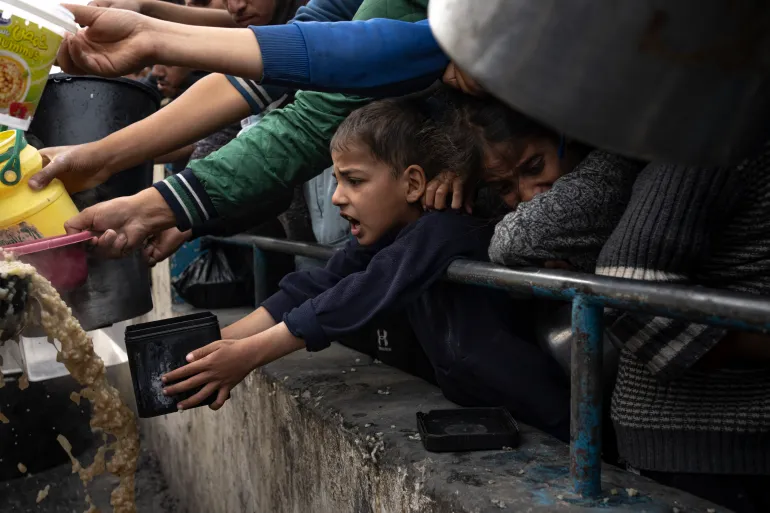A UN-backed assessment states that the whole 2.3 million population of Gaza is experiencing crisis levels of hunger, with the risk of famine increasing daily.
An analysis by the Integrated Food Security Phase Classification (IPC) was released on Thursday, detailing the unprecedented proportion of Gazan households impacted by severe food insecurity.
The report’s data show that the hunger in Gaza is far worse than the near-famines in Yemen and Afghanistan in recent years.
‘Everybody in Gaza is hungry’
“It doesn’t get any worse,” stated Arif Husain, chief economist of the World Food Programme.
“I have never witnessed anything like what is occurring in Gaza, nor has anything happened in the past two months.”
The whole population of Gaza is facing a severe food crisis, with 576,600 people at catastrophic levels of famine, according to a report by 23 UN and nongovernmental agencies.
Almost everyone in Gaza is going hungry, Husain explained.
“People are extremely vulnerable to major disease outbreaks due to their compromised immune systems caused by inadequate nutrition,” he said.
Acute food insecurity is predicted to affect every single person in Gaza over the next six weeks, according to the research.
The “most likely scenario,” according to the 23 agencies’ predictions, would see the entire Gaza Strip population experiencing “crisis or worse” levels of hunger by February 7, following four months of conflict. There are three stages of food insecurity according to the IPC: crisis, emergency, tragedy, or famine.
The research stated that this is the largest percentage of people experiencing severe food insecurity that the IPC program has ever recorded for any specific region or nation.
The figures were deemed “alarming” by the worldwide humanitarian organization CARE.
Since Israel launched a massive military assault on October 7 with heavy air attacks and a ground offensive destroying vast portions of the territory, the humanitarian situation in Gaza has quickly worsened.
As long as the present scenario of heavy warfare and restricted humanitarian access continues or gets worse, the risk of starvation is increasing, according to the IPC for Gaza.
By utilizing a detailed set of technical criteria, the IPC establishes the worldwide norm for assessing the seriousness of a food crisis.
The danger of starvation is “increasing each day,” according to the report, which attributes the problem to inadequate help reaching Gaza.
There has been some food, water, and medicine sent by trucks from Egypt, but according to the UN, the quantity of food is only 10% of what is needed for the displaced people living in the enclave.
Due to communications outages, gasoline shortages, inspections of aid requested by Israel, and military activities, the distribution of help within Gaza has been hindered.
There have been reports of Palestinians in Gaza jumping aboard aid vehicles in an attempt to get their hands on the meager supply of food and other necessities. Some locals have been seen eating donkey meat, while severely underweight patients have been seen pleading for food.
#Gaza
Urgent action is needed.
Hostilities, including bombardment, ground operations & besiegement of the entire population have caused catastrophic levels of acute food insecurity.
There is a risk of Famine.
Read more ➡️https://t.co/b358hNlY4i pic.twitter.com/e9C155XqAP
— The Integrated Food Security Phase Classification (@theIPCinfo) December 21, 2023
At the same time, more than 20,000 people have died as a result of Israel’s ceaseless bombing of Gaza; of these, 70% are children and women.
More than 80% of Gaza’s inhabitants, or around 1.9 million people, have been forcibly removed from their homes. U.N. shelters are overcrowded with over a million people.
Additionally, Gaza’s healthcare system has collapsed due to the war. According to Thursday’s report by the World Health Organization, out of 36 health institutions, just nine are partially operational; all of these are situated in the southern regions.




